An Exploratory Study of COVID-19 Information on Twitter in the Greater Region
Abstract
1. Introduction
- RQ1
- Whether there is a strong correlation between tweet volume and COVID-19 daily cases in the GR and related countries, and, if so, whether tweet volume can help predict COVID-19 daily cases?
- RQ2
- How do the categories of topics discussed change over time in each country and region? Does the changing scenario of the topic categories in the GR differ from that of other countries?
- (I)
- We screen a novel Twitter dataset of 22 January 2020 to 5 June 2020 which contains data from users with locations labelled in the GR, and related countries including Luxembourg, France, Germany and Belgium, and the COVID-19 related tweets from Chen et al’s dataset [20]. This dataset will be shared with the public to advance related research.
- (II)
- Spatio-temporal analysis is carried out to showcase how the COVID-19 daily cases are correlated with tweet volume in a long period. We find that tweet volume and COVID-19 daily cases in the GR and related countries are correlated, and tweet volume can help predict COVID-19 daily cases, but this strong correlation only exists during the early period of the pandemic.
- (III)
- We plot the daily discussions on different topic categories by country and region. It is found that users in the GR show more concern in anti-contagion and treatment measures before COVID-19 reaches its peak, and have a higher level of interest in policy and daily life before than the related countries.
2. Related Work
3. Data Description
3.1. Twitter Data Collection
3.2. COVID-19 Data Collection
4. Correlation between COVID-19 Daily Cases and Tweet Volume
4.1. -Based Time Division
4.2. Research Question RQ1
- H1
- There is a strong correlation between tweet volume and COVID-19 daily cases in the GR and related countries.
- H2
- Tweet volume can help predict COVID-19 daily cases.
5. Topic Modelling and Classification of Tweets
5.1. Text Pre-Processing and Topic Modelling
5.2. Topic Classification
- ‘Wuhan and China’: Topics about Wuhan and China.
- ‘Measures’: Topics about basic information including symptoms, anti-contagion and treatment measures of COVID-19.
- ‘Local news’: Topics about local COVID-19 news, including daily new cases, deaths, etc.
- ‘International news’: Topics about international COVID-19 news
- ‘Policy and daily life’: Topics about COVID-19 related policies encompass lockdown, closure of borders, limits on public gatherings and the impact of the policies on daily life.
- ‘Racism’: Topics about racism.
- ‘Other’: Other topics.
5.3. Research Question RQ2
6. Conclusions and Discussion
Author Contributions
Funding
Conflicts of Interest
References
- Cinelli, M.; Quattrociocchi, W.; Galeazzi, A.; Valensise, C.M.; Brugnoli, E.; Schmidt, A.L.; Zola, P.; Zollo, F.; Scala, A. The COVID-19 Social Media Infodemic; Scientific Reports; Nature Publishing Group: London, UK, 2020. [Google Scholar]
- Singh, L.; Bansal, S.; Bode, L.; Budak, C.; Chi, G.; Kawintiranon, K.; Padden, C.; Vanarsdall, R.; Vraga, E.; Wang, Y. A first look at COVID-19 information and misinformation sharing on Twitter. arXiv 2020, arXiv:2003.13907. [Google Scholar]
- Jahanbin, K.; Rahmanian, V. Using Twitter and web news mining to predict COVID-19 outbreak. Asian Pac. J. Trop. Med. 2020, 13, 26–28. [Google Scholar]
- Wang, C.; David, M.B. Collaborative topic modelling for recommending scientific articles. In Proceedings of the 2011 International Conference on Knowledge Discovery and Data Mining (SIGKDD), San Diego, CA, USA, 21–24 August 2011; pp. 448–456. [Google Scholar]
- Medford, R.J.; Saleh, S.N.; Sumarsono, A.; Perl, T.M.; Lehmann, C.U. An “Infodemic”: Leveraging high-volume Twitter data to understand public sentiment for the COVID-19 outbreak. Open Forum Infect. Dis. 2020, 7. [Google Scholar] [CrossRef]
- Sharma, K.; Seo, S.; Meng, C.; Rambhatla, S.; Liu, Y. COVID-19 on Social Media: Analyzing Misinformation in Twitter Conversations. arXiv 2020, arXiv:2003.12309. [Google Scholar]
- Gupta, S.; Nguyen, T.D.; Rojas, F.L.; Raman, S.; Lee, B.; Bento, A.; Simon, K.I.; Wing, C. Tracking Public and Private Response to the COVID-19 Epidemic: Evidence from State and Local Government Actions; Technical report; National Bureau of Economic Research: Cambridge, MA, USA, 2020. [Google Scholar]
- Bento, A.I.; Nguyen, T.; Wing, C.; Lozano-Rojas, F.; Ahn, Y.Y.; Simon, K. Evidence from Internet search data shows information-seeking responses to news of local COVID-19 cases. Proc. Natl. Acad. Sci. USA 2020, 117, 11220–11222. [Google Scholar] [CrossRef]
- Lopez, C.E.; Vasu, M.; Gallemore, C. Understanding the perception of COVID-19 policies by mining a multilanguage Twitter dataset. arXiv 2020, arXiv:2003.10359. [Google Scholar]
- Thelwall, M.; Thelwall, S. Retweeting for COVID-19: Consensus building, information sharing, dissent, and lockdown life. arXiv 2020, arXiv:2004.02793. [Google Scholar]
- Balcan, D.; Colizza, V.; Gonçalves, B.; Hu, H.; Ramasco, J.J.; Vespignani, A. Multiscale mobility networks and the spatial spreading of infectious diseases. Proc. Natl. Acad. Sci. USA 2009, 106, 21484–21489. [Google Scholar] [CrossRef]
- Sigler, T.J. Relational cities: Doha, Panama City, and Dubai as 21st century entrepôts. Urban Geogr. 2013, 34, 612–633. [Google Scholar] [CrossRef]
- Hesse, M.; Rafferty, M. Relational cities disrupted: reflections on the particular geographies of COVID-19 For small but global urbanisation in Dublin, Ireland, and Luxembourg City, Luxembourg. Tijdschr. Voor Econ. Soc. Geogr. 2020, 111, 451–464. [Google Scholar] [CrossRef]
- Decoville, A.; Durand, F. Challenges and obstacles in the production of cross-border territorial strategies: the example of the Greater Region. Trans. Assoc. Eur. Sch. Plan. 2017, 1, 65–78. [Google Scholar] [CrossRef]
- The Greater Region at a Glance. Available online: http://www.granderegion.net/en/The-Greater-Region-at-a-Glance (accessed on 24 January 2021).
- Heesterbeek, J.A.P.; Dietz, K. The concept of Ro in epidemic theory. Stat. Neerl. 1996, 50, 89–110. [Google Scholar] [CrossRef]
- Devlin, J.; Chang, M.W.; Lee, K.; Toutanova, K. BERT: Pre-training of deep bidirectional transformers for language understanding. In Proceedings of the 2019 Annual Meeting of the Association for Computational Linguistics: Human Language Technologies (HLT), Minneapolis, MN, USA, 2–7 June 2019; Volume 1, pp. 4171–4186. [Google Scholar]
- Blei, D.M.; Ng, A.Y.; Jordan, M.T.I. Latent dirichlet allocation. J. Mach. Learn. Res. 2003, 3, 993–1022. [Google Scholar]
- Chang, C.C.C.; Lin, C.J.J. LIBSVM: A library for support vector machines. Trans. Intell. Syst. Technol. 2011, 2, 1–27. [Google Scholar] [CrossRef]
- Chen, E.; Lerman, K.; Ferrara, E. COVID-19: The First Public Coronavirus Twitter Dataset. arXiv 2020, arXiv:2003.07372. [Google Scholar]
- Depoux, A.; Martin, S.; Karafillakis, E.; Preet, R.; Wilder-Smith, A.; Larson, H. The pandemic of social media panic travels faster than the COVID-19 outbreak. J. Travel Med. 2020, 27, taaa031. [Google Scholar] [CrossRef]
- St Louis, C.; Zorlu, G. Can Twitter predict disease outbreaks? Br. Med J. 2012, 344, e2353. [Google Scholar] [CrossRef]
- Shen, C.; Chen, A.; Luo, C.; Zhang, J.; Feng, B.; Liao, W. Using reports of symptoms and diagnoses on social media to predict COVID-19 case counts in mainland China: observational infoveillance study. J. Med. Internet Res. 2020, 22, e19421. [Google Scholar] [CrossRef]
- Hsiang, S.; Allen, D.; Annan-Phan, S.; Bell, K.; Bolliger, I.; Chong, T.; Druckenmiller, H.; Huang, L.Y.; Hultgren, A.; Krasovich, E.; et al. The effect of large-scale anti-contagion policies on the COVID-19 pandemic. Nature 2020, 584, 262–267. [Google Scholar] [CrossRef]
- Courtemanche, C.; Garuccio, J.; Le, A.; Pinkston, J.; Yelowitz, A. Strong social distancing measures in the United States reduced The COVID-19 Growth Rate. Health Aff. 2020, 39, 1237–1246. [Google Scholar] [CrossRef]
- Dergiades, T.; Milas, C.; Panagiotidis, T. Effectiveness of government policies in response to the COVID-19 outbreak. SSRN 2020. [Google Scholar] [CrossRef]
- Park, H.W.; Park, S.; Chong, M. Conversations and medical news frames on Twitter: Infodemiological study on covid-19 in South Korea. J. Med. Internet Res. 2020, 22, e18897. [Google Scholar] [CrossRef] [PubMed]
- Hu, D.; Lou, X.; Xu, Z.; Meng, N.; Xie, Q.; Zhang, M.; Zou, Y.; Liu, J.; Sun, G.P.; Wang, F. More effective strategies are required to strengthen public awareness of COVID-19: Evidence from Google trends. J. Glob. Health 2020, 10, 011003. [Google Scholar] [CrossRef] [PubMed]
- Effenberger, M.; Kronbichler, A.; Shin, J.I.; Mayer, G.; Tilg, H.; Perco, P. Association of the COVID-19 pandemic with Internet search volumes: A Google trendsTM Analysis. Int. J. Infect. Dis. 2020, 95, 192–197. [Google Scholar] [CrossRef]
- Lwin, M.O.; Lu, J.; Sheldenkar, A.; Schulz, P.J.; Shin, W.; Gupta, R.; Yang, Y. Global sentiments surrounding the COVID-19 pandemic on Twitter: analysis of Twitter trends. JMIR Public Health Surveill. 2020, 6, e19447. [Google Scholar] [CrossRef]
- Samuel, J.; Ali, G.; Rahman, M.; Esawi, E.; Samuel, Y. COVID-19 public sentiment insights and machine learning for tweets classification. Information 2020, 11, 314. [Google Scholar] [CrossRef]
- Abd-Alrazaq, A.; Alhuwail, D.; Househ, M.; Hamdi, M.; Shah, Z. Top concerns of tweeters during the COVID-19 pandemic: infoveillance study. J. Med. Internet Res. 2020, 22, e19016. [Google Scholar] [CrossRef]
- Zamani, M.; Schwartz, H.A.; Eichstaedt, J.; Guntuku, S.C.; Ganesan, A.V.; Clouston, S.; Giorgi, S. Understanding weekly COVID-19 concerns through dynamic content-specific LDA topic modeling. In Proceedings of the 4th Workshop on Natural Language Processing and Computational Social Science (NLP+CSS), online. 20 November 2020; pp. 193–198. [Google Scholar]
- Yan, X.; Guo, J.; Lan, Y.; Cheng, X. A biterm topic model for short texts. In Proceedings of the 22nd International Conference on World Wide Web, Rio de Janeiro, Brazil, 13–17 May 2013; pp. 1445–1456. [Google Scholar]
- Weidemann, C.; Swift, J. Social Media Location Intelligence: The Next Privacy Battle-An ArcGIS add-in and Analysis of Geospatial Data Collected from Twitter. com. Int. J. Geoinform. 2013, 9, 21–27. [Google Scholar]
- Salas-Olmedo, M.H.; Moya-Gómez, B.; García-Palomares, J.C.; Gutiérrez, J. Tourists’ digital footprint in cities: Comparing Big Data sources. Tour. Manag. 2018, 66, 13–25. [Google Scholar] [CrossRef]
- Hecht, B.; Hong, L.; Suh, B.; Chi, E.H. Tweets from Justin Bieber’s heart: the dynamics of the location field in user profiles. In Proceedings of the SIGCHI Conference on Human Factors in Computing Systems, Vancouver, BC, Canada, 7–12 May 2011; pp. 237–246. [Google Scholar]
- Graham, M.; Hale, S.A.; Gaffney, D. Where in the world are you? Geolocation and language identification in Twitter. Prof. Geogr. 2014, 66, 568–578. [Google Scholar] [CrossRef]
- European Centre for Disease Prevention and Control. 2020. Available online: https://www.ecdc.europa.eu/en (accessed on 24 January 2021).
- Sciensano: Belgian Institute for Health. 2020. Available online: https://epistat.wiv-isp.be/covid/ (accessed on 24 January 2021).
- NPGEO Corona Hub 2020. 2020. Available online: https://npgeo-corona-npgeo-de.hub.arcgis.com/ (accessed on 24 January 2021).
- Données Hospitalières Relatives à l’épidémie de COVID-19. 2020. Available online: https://www.data.gouv.fr/fr/datasets/donnees-hospitalieres-relatives-a-lepidemie-de-covid-19 (accessed on 24 January 2021).
- Bettencourt, L.M.L.M.A.; Ribeiro, R.M. Real time Bayesian estimation of the epidemic potential of emerging infectious diseases. PLoS ONE 2008, 3, e2185. [Google Scholar] [CrossRef] [PubMed]
- A Collection of Work Related to COVID-19. 2020. Available online: https://github.com/k-sys/covid-19 (accessed on 24 January 2021).
- Wu, J.T.; Leung, K.; Leung, G.M. Nowcasting and forecasting the potential domestic and international spread of the 2019-nCoV outbreak originating in Wuhan, China: A modelling study. Lancet 2020, 395, 689–697. [Google Scholar] [CrossRef]
- Shen, M.; Peng, Z.; Xiao, Y.; Zhang, L. Modelling the epidemic trend of the 2019 novel coronavirus outbreak in China. BioRxiv 2020. [Google Scholar] [CrossRef]
- Walker, P.; Whittaker, C.; Watson, O.; Baguelin, M.; Ainslie, K.; Bhatia, S. The Global Impact of COVID-19 and Strategies for Mitigation and Suppression. 2020. Available online: https://www.imperial.ac.uk/mrc-global-infectious-disease-analysis/covid-19/report-12-global-impact-covid-19/ (accessed on 24 January 2021).
- Riou, J.; Althaus, C.L. Pattern of early human-to-human transmission of Wuhan 2019 novel coronavirus (2019-nCoV), December 2019 to January 2020. Eurosurveillance 2020, 25, 2000058. [Google Scholar] [CrossRef]
- Statement on the First Meeting of the International Health Regulations (2005) Emergency Committee Regarding the Outbreak of Novel Coronavirus (2019-nCoV). 2020. Available online: https://www.who.int/news/item/23-01-2020-statement-on-themeeting-of-the-international-health-regulations-(2005)-emergency-committee-regarding-the-outbreak-of-novel-coronavirus-(2019-ncov) (accessed on 24 January 2021).
- Younis, J.; Freitag, H.; Ruthberg, J.S.; Romanes, J.P.; Nielsen, C.; Mehta, N. Social media as an early proxy for social distancing indicated by the COVID-19 reproduction number: observational study. JMIR Public Health Surveill. 2020, 6, e21340. [Google Scholar] [CrossRef]
- Smith, M.C.; Broniatowski, D.A.; Paul, M.J.; Dredze, M. Towards real-time measurement of public epidemic awareness: Monitoring influenza awareness through twitter. In Proceedings of the Spring Symposium on Observational Studies Through Social Media and Other Human-generated Content, Stanford, CA, USA, 21–23 March 2016; Volume 20052, p. e198. [Google Scholar]
- Pang, P.C.I.; McKay, D.; Chang, S.; Chen, Q.; Zhang, X.; Cui, L. Privacy concerns of the Australian My Health Record: Implications for other large-scale opt-out personal health records. Inf. Process. Manag. 2020, 57, 102364. [Google Scholar] [CrossRef]
- Kolini, F.; Janczewski, L. Clustering and topic modelling: A new approach for analysis of national cyber security strategies. In Proceedings of the Pacific Asia Conference on Information Systems. Association For Information Systems, Langkawi, Malaysia, 16–20 July 2017. [Google Scholar]
- Garbe, W. Python port of SymSpell. Available online: https://github.com/mammothb/symspellpy (accessed on 24 January 2021).
- Sinka, M.P.; Corne, D.W. Towards modernised and web-specific stoplists for web document analysis. In Proceedings of the IEEE/WIC International Conference on Web Intelligence (WI), Halifax, NS, Canada, 13–17 October 2003; pp. 396–402. [Google Scholar]
- Älgå, A.; Eriksson, O.; Nordberg, M. Analysis of scientific publications during the early phase of the COVID-19 pandemic: Topic modeling study. J. Med Internet Res. 2020, 22, e21559. [Google Scholar] [CrossRef]
- Contextual Topic Identification for Steam Reviews. Available online: https://github.com/Stveshawn/contextual_topic_identification (accessed on 24 January 2021).
- Wagstaff, K.; Cardie, C.; Rogers, S.; Schrödl, S. Constrained k-means clustering with background knowledge. In Proceedings of the 2001 International Conference on Machine Learning (ICML). Citeseer, Williamstown, MA, USA, 28 June–1 July 2001; Volume 1, pp. 577–584. [Google Scholar]
- McInnes, L.; Healy, J.; Melville, J. Umap: Uniform manifold approximation and projection for dimension reduction. arXiv 2018, arXiv:1802.03426. [Google Scholar]
- Gutiérrez, E.D.; Shutova, E.; Lichtenstein, P.; de Melo, G.; Gilardi, L. Detecting cross-cultural differences using a multilingual topic model. Trans. Assoc. Comput. Linguist. 2016, 4, 47–60. [Google Scholar] [CrossRef]
- Ramos, J. Using TF-IDF to determine word relevance in document queries. In Proceedings of the 2003 International Conference on Machine Learning (ICML), Washington, DC, USA, 21–24 August 2003; Volume 242, pp. 133–142. [Google Scholar]
- O’callaghan, D.; Greene, D.; Carthy, J.; Cunningham, P.; O’Callaghan, D.; Greene, D.; Carthy, J.; Cunningham, P. An analysis of the coherence of descriptors in topic modelling. Expert Syst. Appl. 2015, 42, 5645–5657. [Google Scholar] [CrossRef]
- Newman, D.; Lau, J.H.; Grieser, K.; Baldwin, T. Automatic evaluation of topic coherence. In Proceedings of the 2010 Annual Meeting of the Association for Computational Linguistics: Human Language Technologies, ACL, Los Angeles, CA, USA, 2–4 June 2010; pp. 100–108. [Google Scholar]
- Aranganayagi, S.; Thangavel, K. Clustering categorical data using silhouette coefficient as a relocating measure. In Proceedings of the 2007 International Conference on Computational Intelligence and Multimedia Applications, Sivakasi, Tamil Nadu, India, 13–15 December 2007; Volume 2, pp. 13–17. [Google Scholar]
- Liu, B.; Li, X.; Lee, W.S.; Yu, P.S. Text classification by labeling words. In Proceedings of the AAAI, San Jose, CA, USA, 25–29 July 2004; Volume 4, pp. 425–430. [Google Scholar]
- Lee, K.; Palsetia, D.; Narayanan, R.; Patwary, M.M.A.; Agrawal, A.; Choudhary, A. Twitter trending topic classification. In Proceedings of the 2011 IEEE International Conference on Data Mining Workshops (ICDM), Vancouver, BC, Canada, 11 December 2011; pp. 251–258. [Google Scholar]
- Pedregosa, F.; Varoquaux, G.; Gramfort, A.; Michel, V.; Thirion, B.; Grisel, O.; Blondel, M.; Prettenhofer, P.; Weiss, R.; Dubourg, V.; et al. Scikit-learn: Machine Learning in Python. J. Mach. Learn. Res. 2011, 12, 2825–2830. [Google Scholar]
- Chawla, N.V.; Bowyer, K.W.; Hall, L.O.; Kegelmeyer, W.P. SMOTE: Synthetic minority over-sampling technique. J. Artif. Intell. Res. 2002, 16, 321–357. [Google Scholar] [CrossRef]
- Total Population, Luxembourgers and Foreigners, of Usual Residence in Luxembourg. 2019. Available online: https://statistiques.public.lu/stat/TableViewer/tableView.aspx?ReportId=12856 (accessed on 24 January 2021).
- Smith, M.C.; Broniatowski, D.A.; Paul, M.J.; Dredze, M. Using social and behavioural science to support COVID-19 pandemic response. Nat. Hum. Behav. 2020, 4, 1–12. [Google Scholar]
- Sharot, T. The optimism bias. Curr. Biol. 2011, 21, 941–945. [Google Scholar] [CrossRef]
- Paek, H.J.J.; Hilyard, K.; Freimuth, V.S.; Barge, J.K.; Mindlin, M. Public support for government actions during a flu pandemic: lessons learned from a statewide survey. Health Promot. Pract. 2008, 9, 60–72. [Google Scholar] [CrossRef]

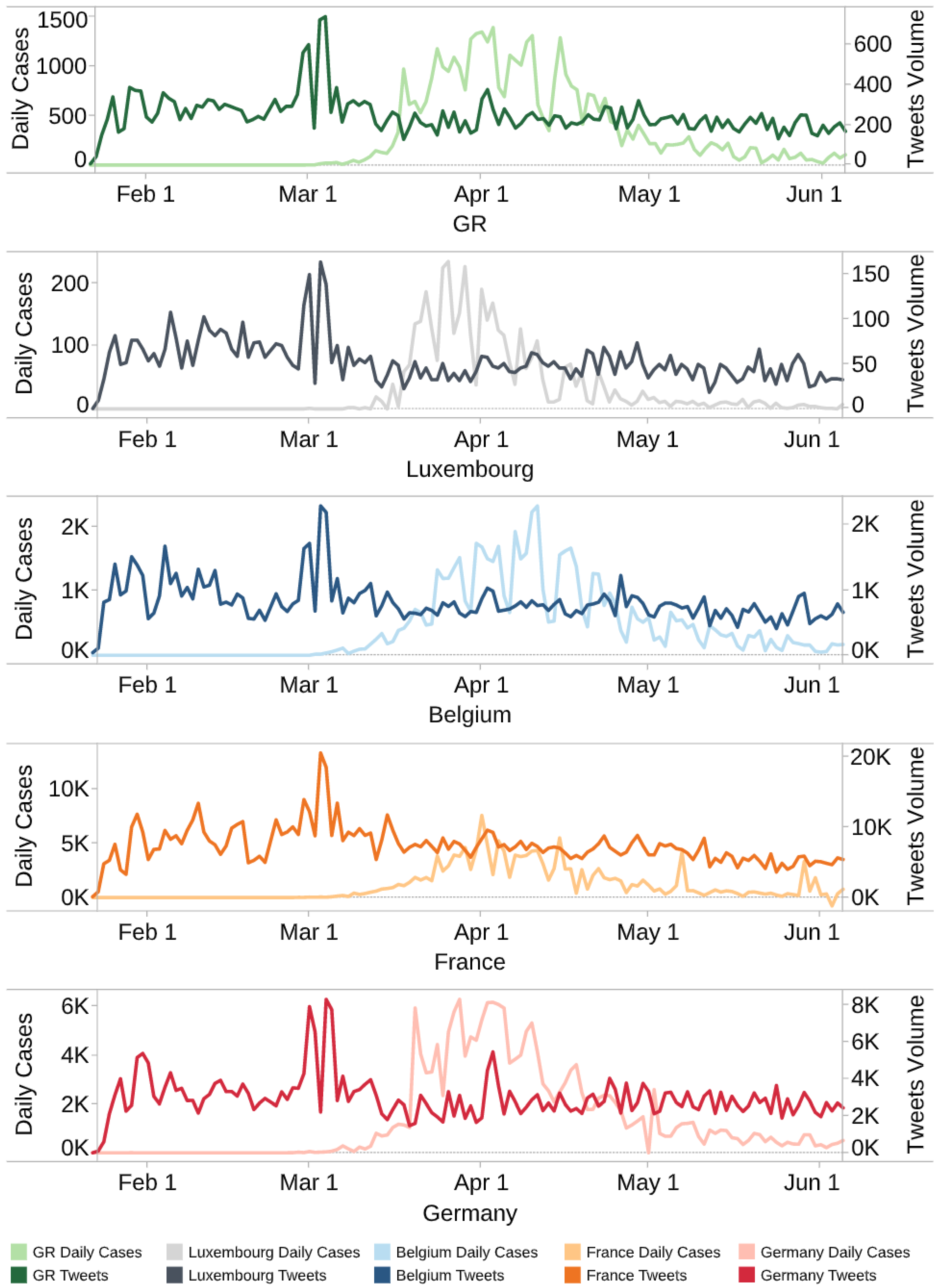
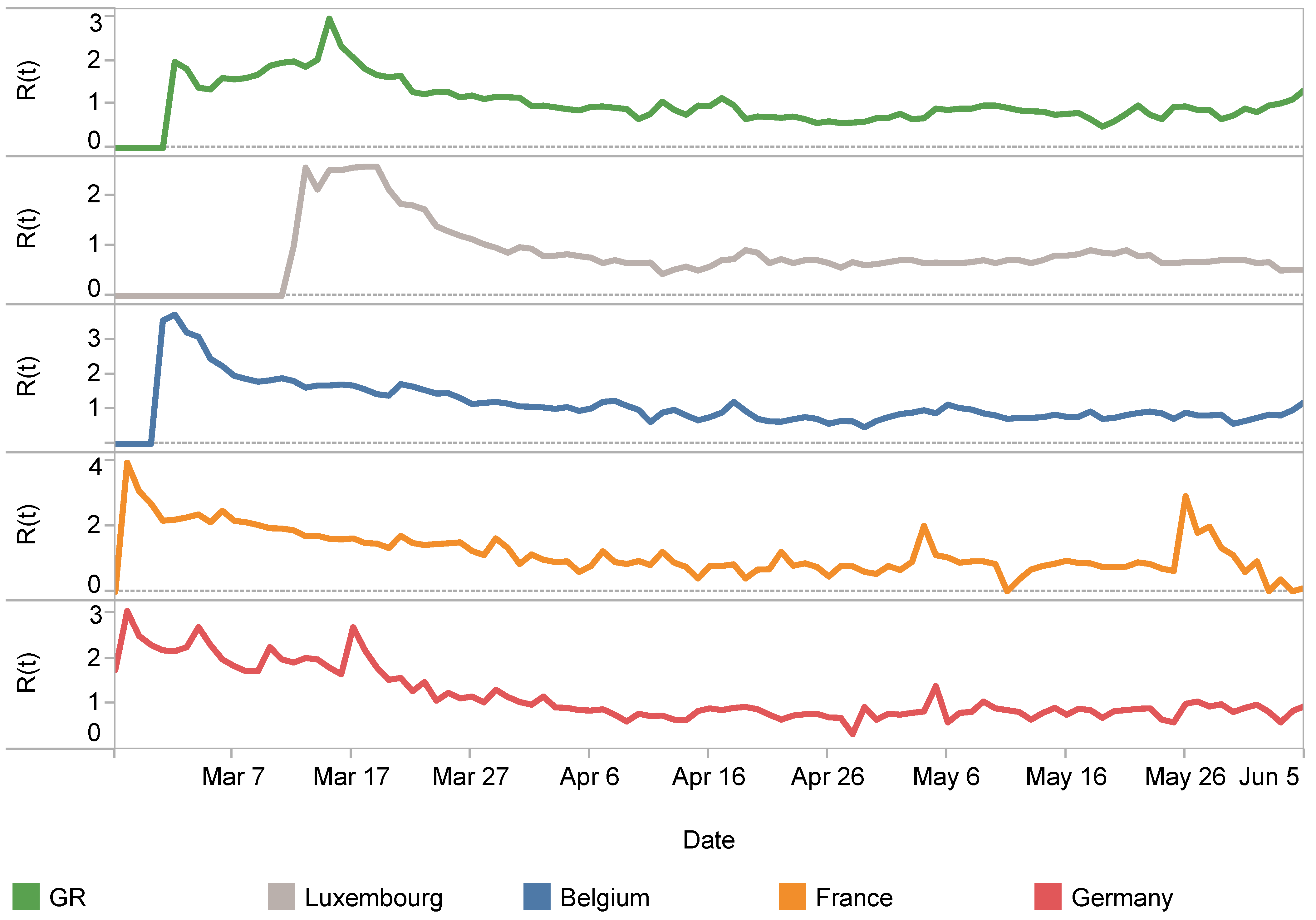
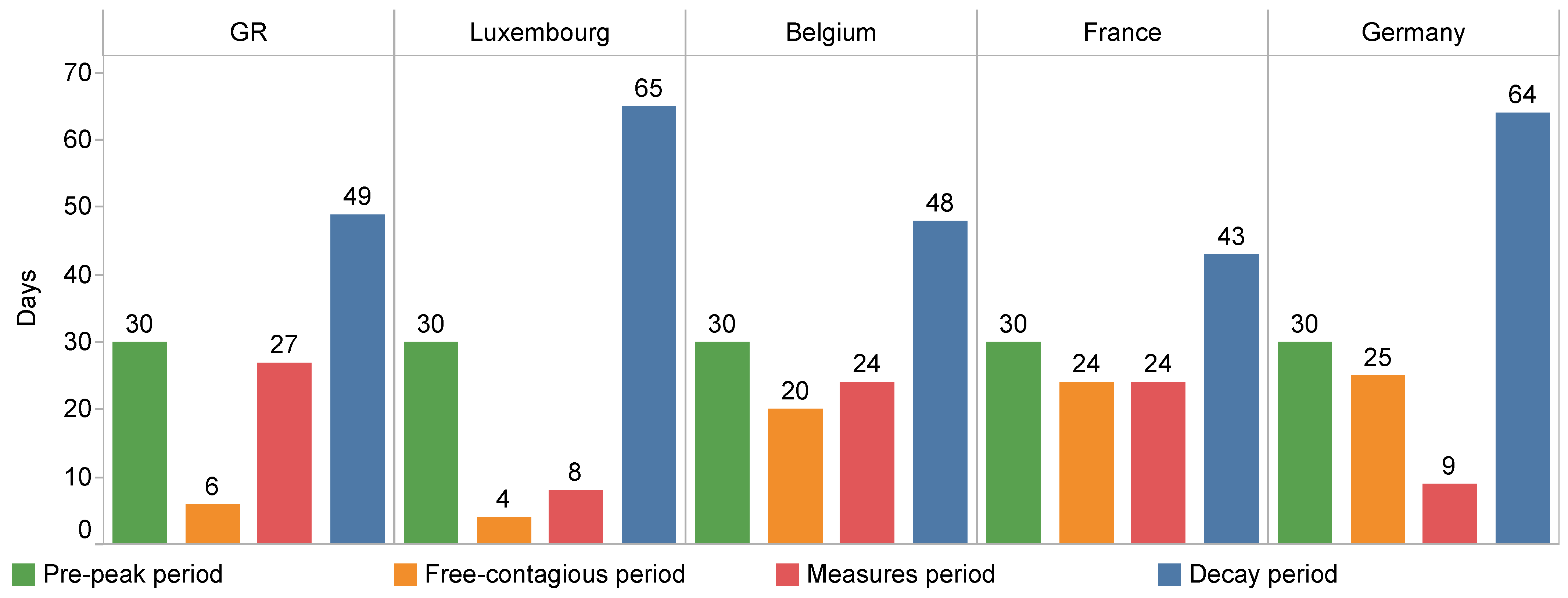
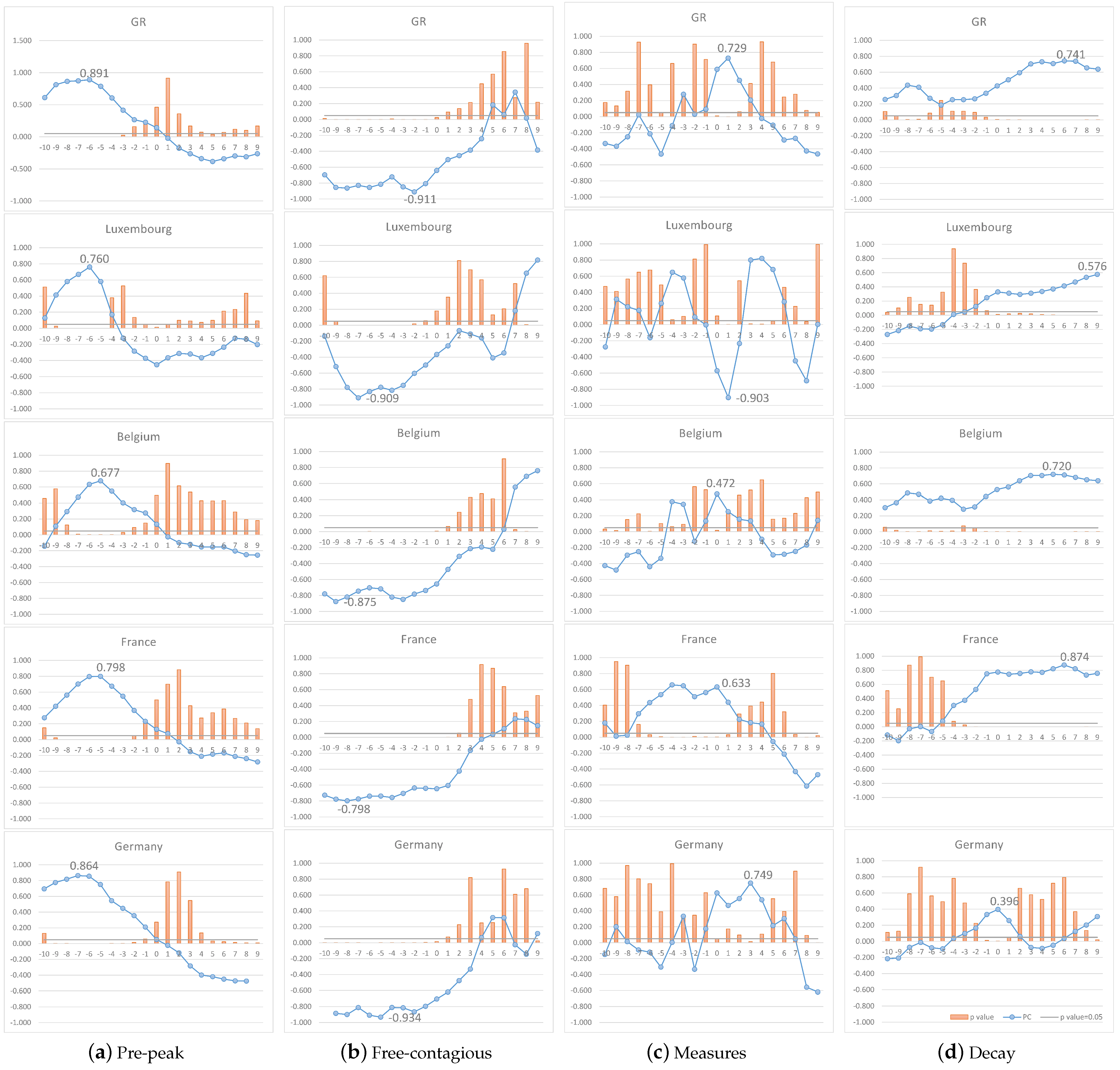
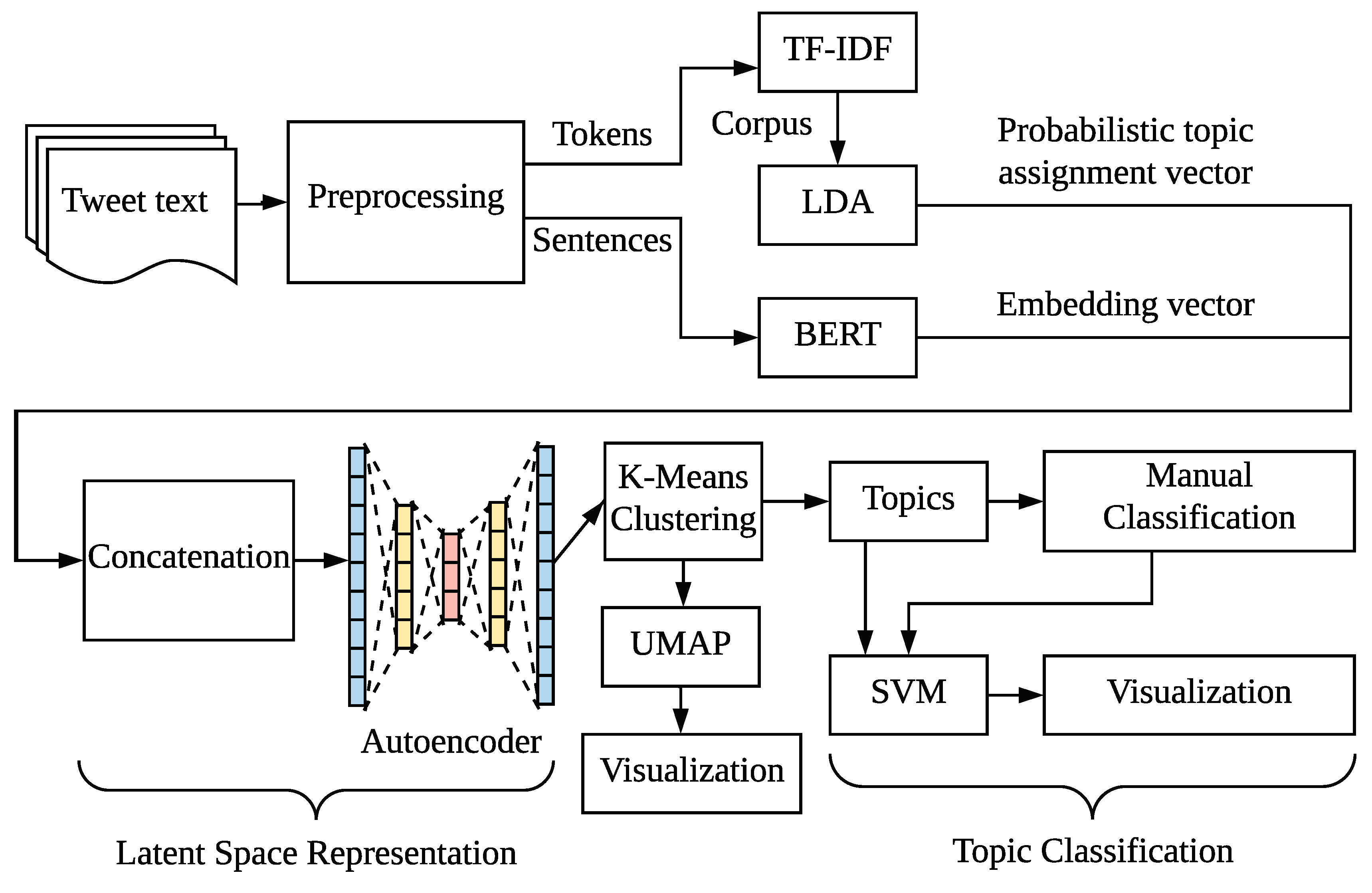
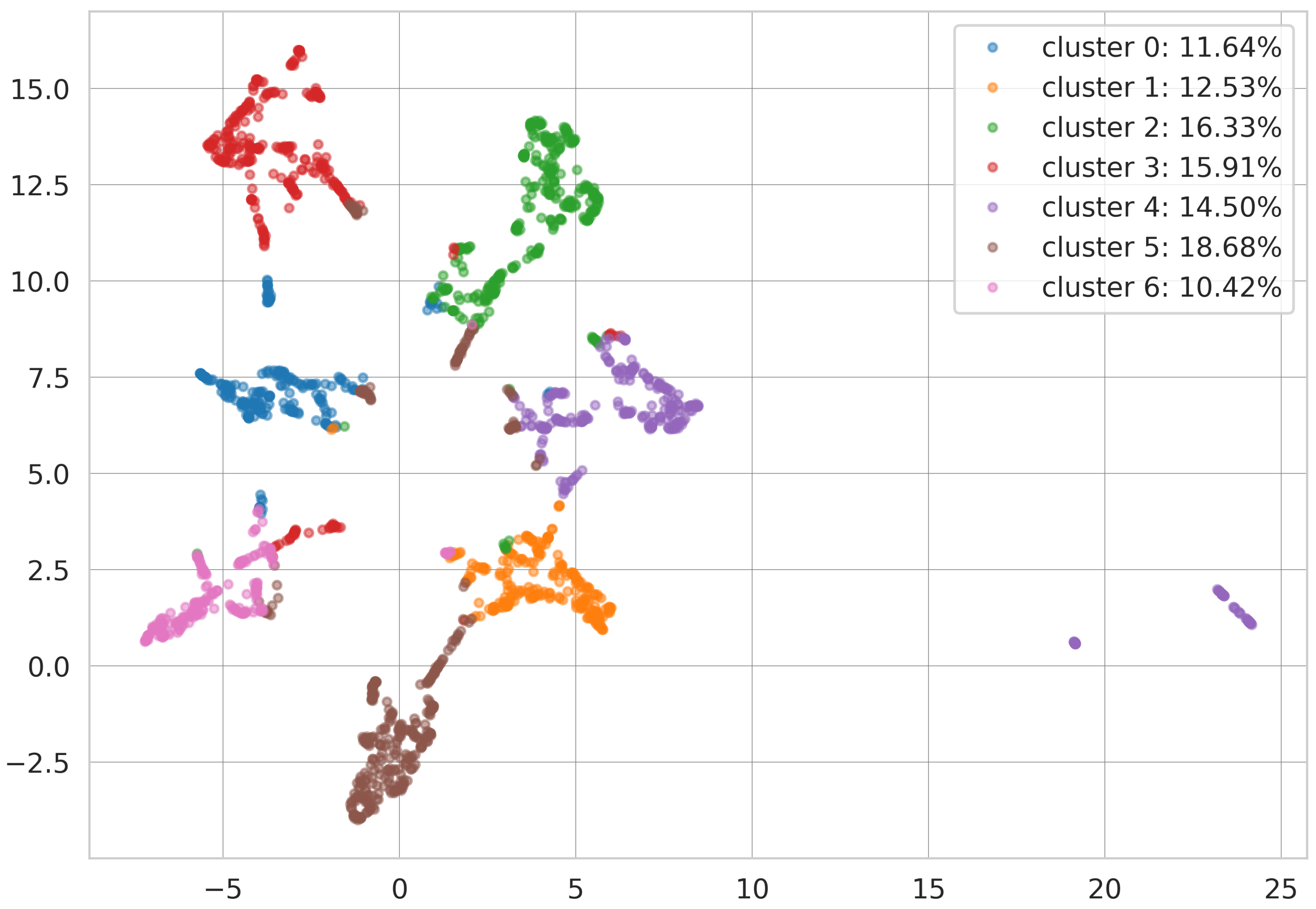
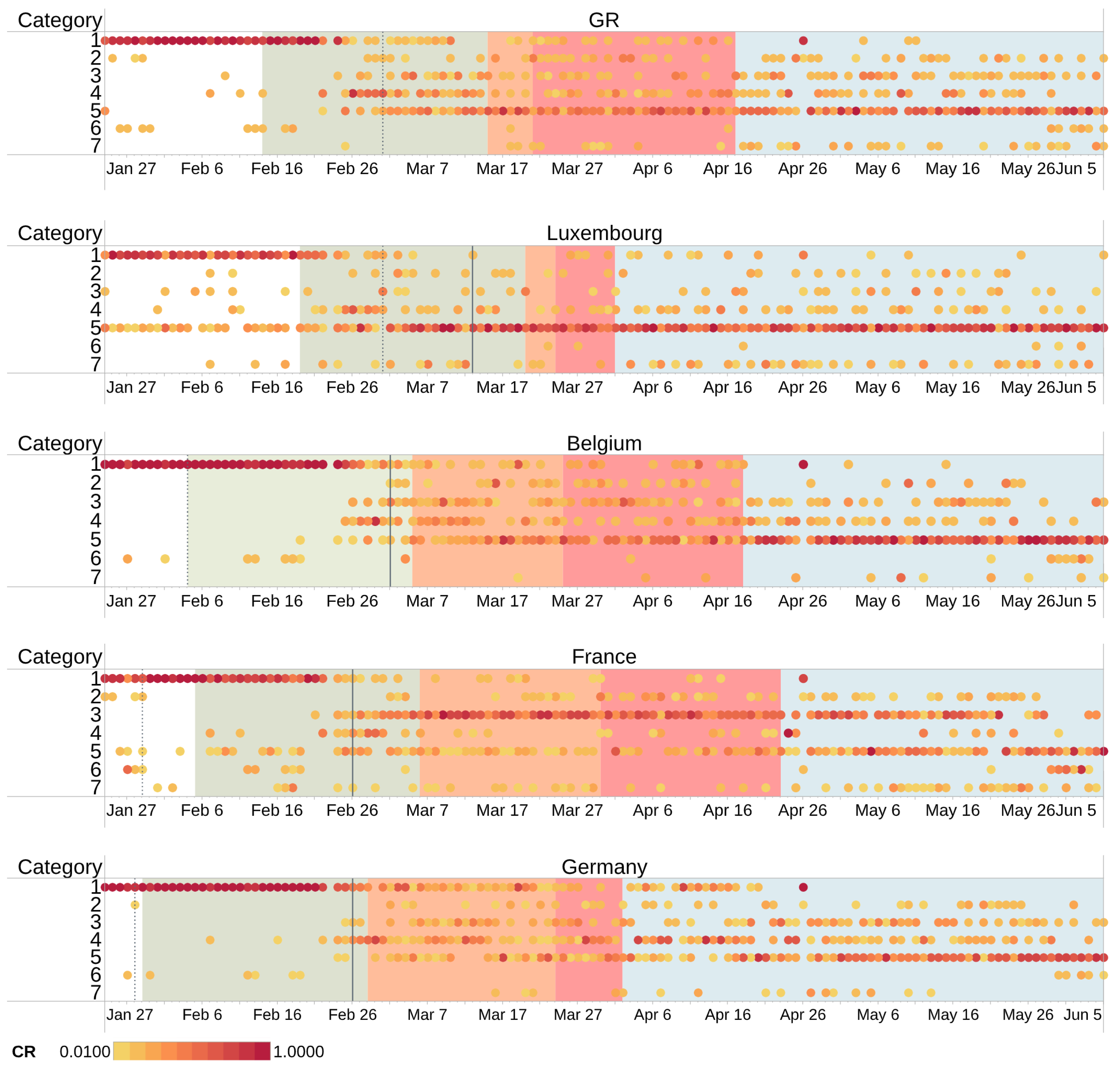
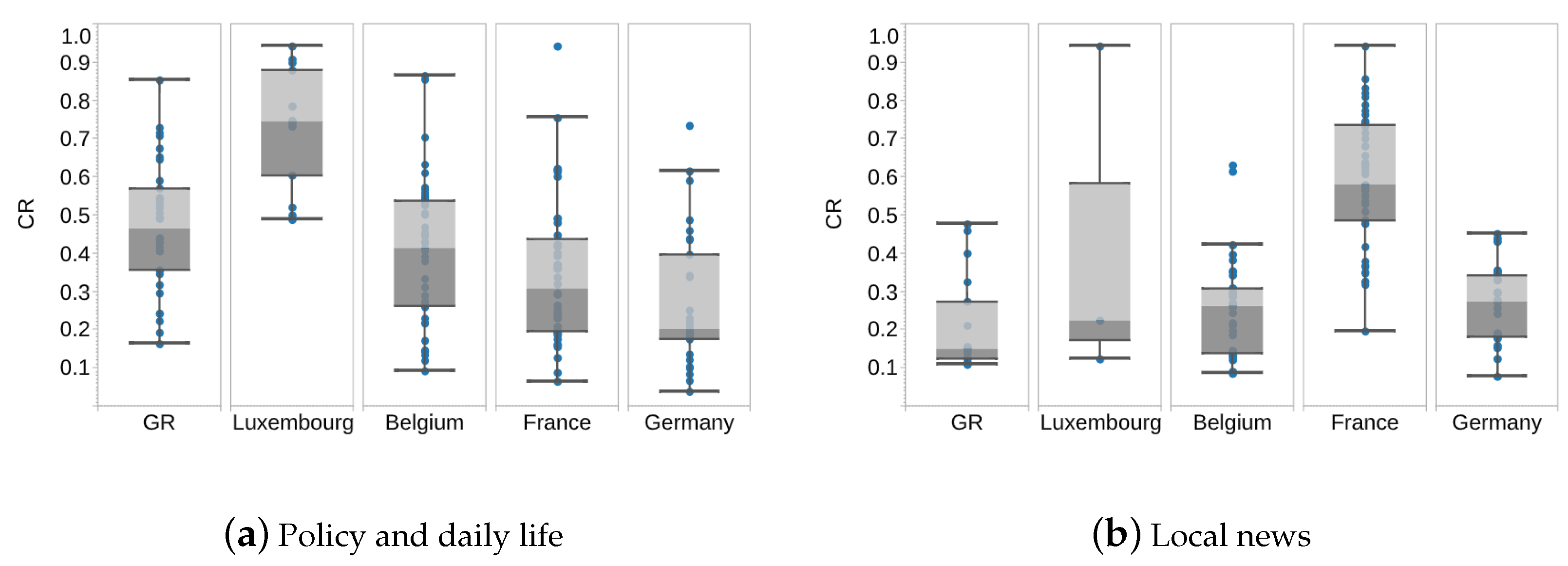
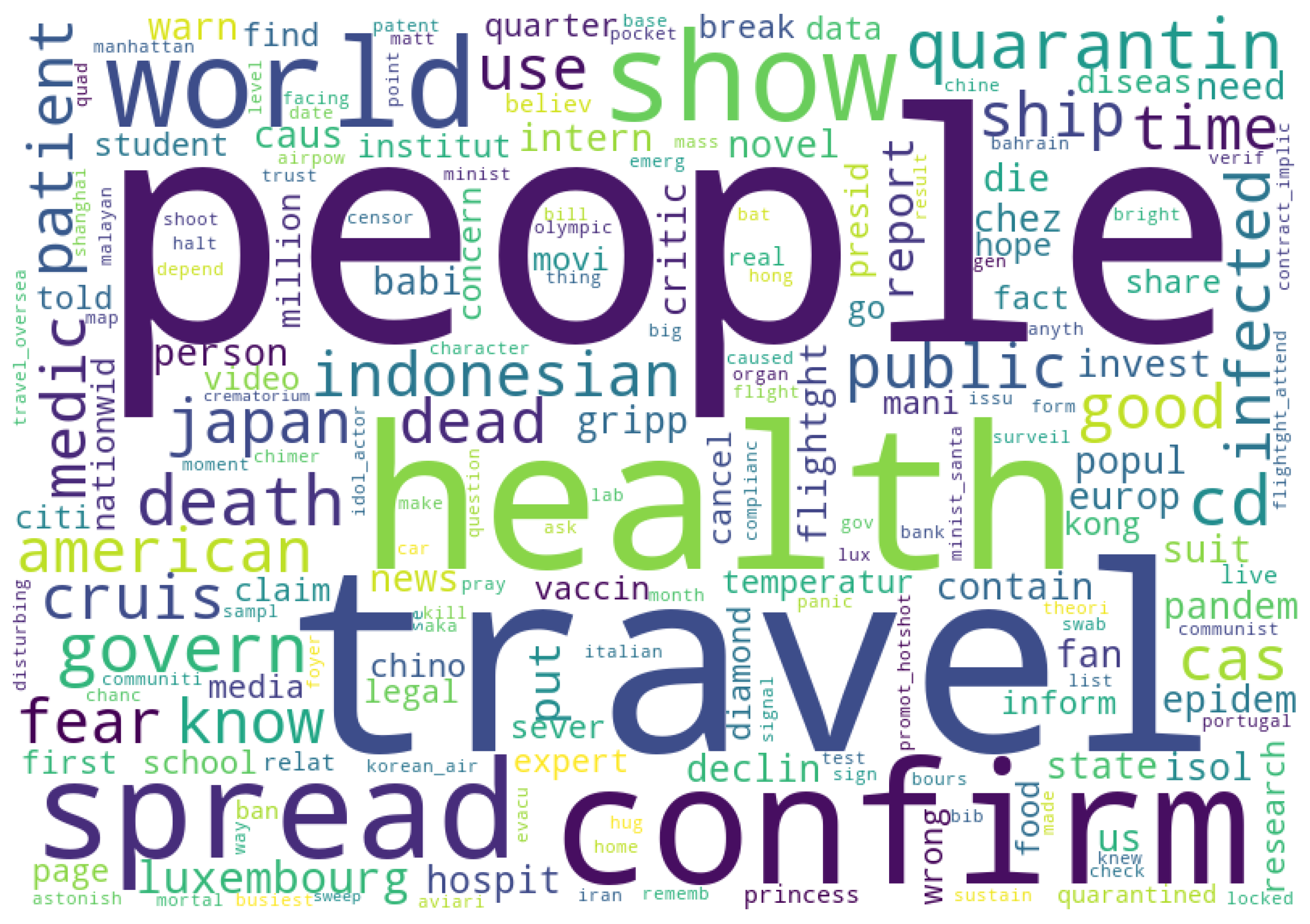
| Attribute | Description | Example |
|---|---|---|
| Tweet_id | A unique identifier for a Tweet | 12319668395****** |
| Full_text | Text of a tweet | RT @******: The Diamond princess is a UK ship managed by the US. UK should Be Responsible. #DiamondPrincess #coronavirus |
| User_id | Unique identifier for this user | u9181074902***** |
| User_geo_orginal | User-defined location information | Moselle |
| User_geo | Geocoded user location | Moselle, Lorraine, France |
| Region/Country | Tweet Volume | USer Volume |
|---|---|---|
| 51,966,639 | 15,551,266 | |
| The GR | 35,329 | 7894 |
| Luxembourg | 7512 | 1545 |
| Belgium | 119,467 | 31,446 |
| France | 1,050,312 | 288,009 |
| Germany | 430,688 | 87,796 |
| Pre-Peak | Free-Contagious | Measures Period | Decay Period | |
|---|---|---|---|---|
| The GR | 2/14–3/15/2020 | 3/15–3/21/2020 | 3/21–4/17/2020 | 4/17–6/05/2020 |
| Luxembourg | 2/19–3/20/2020 | 3/20–3/24/2020 | 3/24–4/01/2020 | 4/01–6/05/2020 |
| Belgium | 2/04–3/05/2020 | 3/05–3/25/2020 | 3/25–4/18/2020 | 4/18–6/05/2020 |
| France | 2/05–3/06/2020 | 3/06–3/30/2020 | 3/30–4/23/2020 | 4/23– 6/05/2020 |
| Germany | 1/29–2/28/2020 | 2/28–3/24/2020 | 3/24–4/02/2020 | 4/02–6/05/2020 |
| Country | Coherence Score | Silhouette Score |
|---|---|---|
| The GR | 0.432 | 0.893 |
| Luxembourg | 0.474 | 0.894 |
| France | 0.351 | 0.590 |
| Belgium | 0.377 | 0.864 |
| Germany | 0.336 | 0.655 |
| Category | Precision | Recall | F1-Score | Support |
|---|---|---|---|---|
| 1 | 0.89 | 0.77 | 0.82 | 163 |
| 2 | 0.92 | 0.93 | 0.93 | 166 |
| 3 | 0.80 | 0.79 | 0.80 | 155 |
| 4 | 0.74 | 0.86 | 0.80 | 155 |
| 5 | 0.73 | 0.68 | 0.71 | 149 |
| 6 | 0.99 | 1.00 | 0.99 | 157 |
| 7 | 0.97 | 1.00 | 0.98 | 142 |
| Macro avg | 0.86 | 0.86 | 0.86 | 1087 |
| Category | The GR | Luxembourg | Belgium | France | Germany | Total |
|---|---|---|---|---|---|---|
| 1 | 245 | 168 | 287 | 202 | 315 | 1217 |
| 2 | 64 | 34 | 48 | 65 | 41 | 252 |
| 3 | 99 | 44 | 109 | 285 | 110 | 647 |
| %midrule 4 | 134 | 77 | 114 | 52 | 167 | 544 |
| 5 | 353 | 525 | 370 | 250 | 295 | 1793 |
| 6 | 23 | 7 | 23 | 31 | 15 | 99 |
| 7 | 41 | 72 | 15 | 60 | 23 | 211 |
| Total | 959 | 927 | 966 | 945 | 966 | 4763 |
Publisher’s Note: MDPI stays neutral with regard to jurisdictional claims in published maps and institutional affiliations. |
© 2021 by the authors. Licensee MDPI, Basel, Switzerland. This article is an open access article distributed under the terms and conditions of the Creative Commons Attribution (CC BY) license (http://creativecommons.org/licenses/by/4.0/).
Share and Cite
Chen, N.; Zhong, Z.; Pang, J. An Exploratory Study of COVID-19 Information on Twitter in the Greater Region. Big Data Cogn. Comput. 2021, 5, 5. https://doi.org/10.3390/bdcc5010005
Chen N, Zhong Z, Pang J. An Exploratory Study of COVID-19 Information on Twitter in the Greater Region. Big Data and Cognitive Computing. 2021; 5(1):5. https://doi.org/10.3390/bdcc5010005
Chicago/Turabian StyleChen, Ninghan, Zhiqiang Zhong, and Jun Pang. 2021. "An Exploratory Study of COVID-19 Information on Twitter in the Greater Region" Big Data and Cognitive Computing 5, no. 1: 5. https://doi.org/10.3390/bdcc5010005
APA StyleChen, N., Zhong, Z., & Pang, J. (2021). An Exploratory Study of COVID-19 Information on Twitter in the Greater Region. Big Data and Cognitive Computing, 5(1), 5. https://doi.org/10.3390/bdcc5010005







